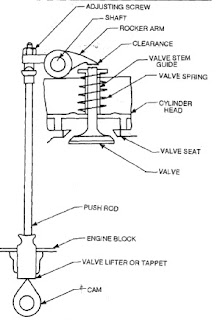The valves used in four stroke engines are operated by two mechanisms.
1. valve mechanism for operating the valve in engine block or straight or side
valve mechanism.
2. Valve mechanism for operating the valve in cylinder head or over head
valve mechanism.
Side valve operating mechanism
This mechanism is used in the engine block. It is mostly adopted in L,T and F type engine heads. The valve stem slides up and down in the valve stem guide which acts as a slipper bearing. It also prevents the gases from passing from the valve port to the valve chamber of the engine block. Valve spring is fitted between the engine block and spring retainer, which keeps the valve closed tightly on the valve seat, until lifted by the valve tappet by the rotation of the cam. The tappet or lifter is held between guide which is generally a part of the engine block. Adjusting screw is provided on the tappet to adjust the clearance between the upper end of the tappet and the bottom of the valve stem. As the cam rotates, it lifts the tappet which lifts the valve to the open position thus connecting the valve part tot the combustion chamber.
Valve seat inserts are fitted on the valve seats. These inserts are in the form of rings tapered grounded to suit the valve faces, and made of special alloy steels. Usually they are used only on exhaust valve seats. They reduce wear and can be replaced when worn out.
Over head valve mechanism:
It is used in I type and F type engine heads. This type valve operating mechanism requires a push rod and a rocker arm. As the cam rotates, it lifts the valve tappet or the lifter which actuates the push rod. The push rod rotates the rocker arm about a shaft- the rocker arm shaft, or a ball joint in some designs to cause one end to push down on the valve stem to open the valve, thus connecting the valve port with the combustion chamber. In this mechanism, the valve tappet clearance is between the rocker arm and valve stem. It is adjusted by means of an adjusting screw on the rocker-arm end that contacts the push rod.


No comments:
Post a Comment